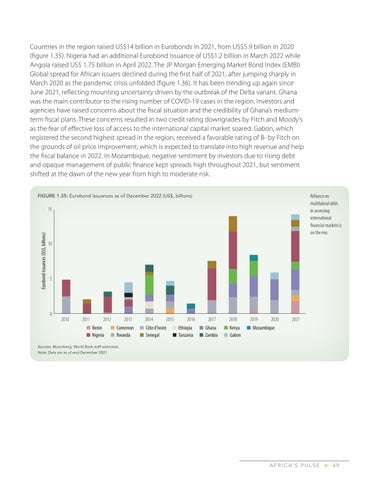Countries in the region raised US$14 billion in Eurobonds in 2021, from US$5.9 billion in 2020 (figure 1.35). Nigeria had an additional Eurobond issuance of US$1.2 billion in March 2022 while Angola raised US$ 1.75 billion in April 2022. The JP Morgan Emerging Market Bond Index (EMBI) Global spread for African issuers declined during the first half of 2021, after jumping sharply in March 2020 as the pandemic crisis unfolded (figure 1.36). It has been trending up again since June 2021, reflecting mounting uncertainty driven by the outbreak of the Delta variant. Ghana was the main contributor to the rising number of COVID-19 cases in the region. Investors and agencies have raised concerns about the fiscal situation and the credibility of Ghana’s mediumterm fiscal plans. These concerns resulted in two credit rating downgrades by Fitch and Moody’s as the fear of effective loss of access to the international capital market soared. Gabon, which registered the second highest spread in the region, received a favorable rating of B- by Fitch on the grounds of oil price improvement, which is expected to translate into high revenue and help the fiscal balance in 2022. In Mozambique, negative sentiment by investors due to rising debt and opaque management of public finance kept spreads high throughout 2021, but sentiment shifted at the dawn of the new year from high to moderate risk. Reliance on multilateral debt in accessing international financial markets is on the rise.
FIGURE 1.35: Eurobond Issuances as of December 2022 (US$, billions)
Eurobond issuances (US$, billions)
15
10
5
0
2010
2011
2012 Benin Nigeria
2013 Cameroon Rwanda
2014
2015
Côte d'Ivoire Senegal
2016 Ethiopia Tanzania
2017 Ghana Zambia
2018 Kenya Gabon
2019
2020
2021
Mozambique
Sources: Bloomberg; World Bank staff estimates. Note: Data are as of end-December 2021.
A F R I C A’ S P U L S E
>
49

